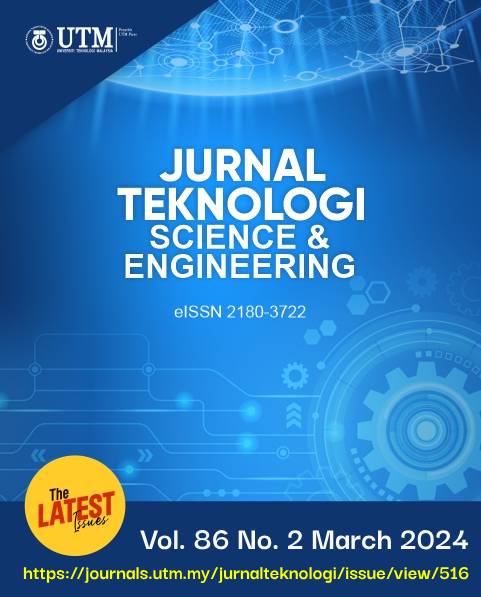GAS SOURCE LOCALIZATION THROUGH DEEP LEARNING METHOD BASED ON GAS DISTRIBUTION MAP DATABASE
DOI:
https://doi.org/10.11113/jurnalteknologi.v86.20186Keywords:
Gas source localization, gas distribution map, deep learning, harmful gas dispersion, mobile robot olfactionAbstract
The incident of harmful gas leakage can cause severe damage to the environment and several casualties to human beings while the gas localization system plays a major role in mitigating those causalities. With the advances in artificial intelligence technology, deep learning is able to enhance the accuracy of the gas localization system to locate the gas source. This paper proposes a gas localization system that utilizes three different deep learning models namely DNN, 1DCNN, and 2DCNN to locate the gas source within the gas map. The proposed method involves generating the gas distribution map through the large gas sensor array platform in real-world indoor scenarios. Those models are then trained using the collected database which allows for accurate prediction of the gas source location. The performance of each proposed deep learning model was compared to find the best model demonstrating the highest effectiveness in identifying gas leaks. The study has shown that the 1DCNN has the highest effectiveness in predicting the gas source in the range between 0.0 m to 0.3 m with 90.3% compared to the DNN and 2DCNN models.
References
C. Bilgera, A. Yamamoto, M. Sawano, H. Matsukura, and H. Ishida. 2018. Application of Convolutional Long Short-term Memory Neural Networks to Signals Collected from a Sensor Network for Autonomous Gas Source Localization in Outdoor Environments. Sensors (Switzerland). 18(12). Doi: 10.3390/s18124484.
F. Rahbar, A. Marjovi, and A. Martinoli. 2019. Design and Performance Evaluation of an Algorithm based on Source Term Estimation for Odor Source Localization. Sensors (Switzerland). 19(3). Doi: 10.3390/s19030656.
C. Liu, Y. Li, L. Fang, and M. Xu. 2019. New Leak-localization Approaches for Gas Pipelines using Acoustic Waves. Meas. J. Int. Meas. Confed. 134: 54-65. Doi: 10.1016/j.measurement.2018.10.052.
X. Liu, Z. Peng, X. Liu, and R. Zhou. 2020. Dispersion Characteristics of Hazardous Gas and Exposure Risk Assessment in a Multiroom Building Environment. Int. J. Environ. Res. Public Health. 17(1). Doi: 10.3390/ijerph17010199.
N. Evalina and H. A. Azis. 2020. Implementation and Design Gas Leakage Detection System using ATMega8 Microcontroller. IOP Conf. Ser. Mater. Sci. Eng. 821(1): 012049. Doi: 10.1088/1757-899X/821/1/012049.
C. Bilgera, A. Yamamoto, M. Sawano, H. Matsukura, and H. Ishida. 2018. Application of Convolutional Long Short-term Memory Neural Networks to Signals Collected from a Sensor Network for Autonomous Gas Source Localization in Outdoor Environments. Sensors (Switzerland). 18(12). Doi: 10.3390/s18124484.
L. Marques, A. Martins, and A. T. de Almeida. 2005. Environmental Monitoring with Mobile Robots. 2005 IEEE/RSJ International Conference on Intelligent Robots and Systems. 3624-3629. Doi: 10.1109/IROS.2005.1545133.
X. xing Chen and J. Huang. 2019. Odor Source Localization Algorithms on Mobile Robots: A Review and Future Outlook. Rob. Auton. Syst. 112: 123-136. Doi: 10.1016/j.robot.2018.11.014.
B. Bayat, N. Crasta, A. Crespi, A. M. Pascoal, and A. Ijspeert. 2017. Environmental Monitoring using Autonomous Vehicles: A Survey of Recent Searching Techniques. Curr. Opin. Biotechnol. 45(645141): 76-84. Doi: 10.1016/j.copbio.2017.01.009.
S. Asadi and A. Lilienthal. 2015. Approaches to Time-Dependent Gas Distribution Modelling. 2015 Eur. Conf. Mob. Robot. ECMR 2015 - Proc. Doi: 10.1109/ECMR.2015.7324215.
A. Lilienthal and T. Duckett. 2004. Building Gas Concentration Gridmaps with a Mobile Robot. Rob. Auton. Syst. 48(1): 3-16. Doi: 10.1016/j.robot.2004.05.002.
A. J. Lilienthal, M. Reggente, M. Trinca, J. L. Blanco, and J. Gonzalez. 2009. A Statistical Approach to Gas Distribution Modelling with Mobile Robots - The Kernel DM+V Algorithm. 2009 IEEE/RSJ Int. Conf. Intell. Robot. Syst. IROS 2009. 570-576. Doi: 10.1109/IROS.2009.5354304.
M. G. W Khalaf, C. Pace. 2008. Gas Detection via Machine Learning. Int. J. Comput. Electr. Autom. Control Inf. 2(1): 61-65.
S. Mahfouz, F. Mourad-chehade, P. Honeine, J. Farah, and H. Snoussi. 2016. Machine Learning in WSNs. 16(14): 5795-5804.
H. Kim, M. Park, C. W. Kim, and D. Shin. 2019. Source Localization for Hazardous Material Release in an Outdoor Chemical Plant via a Combination of LSTM-RNN and CFD Simulation. Comput. Chem. Eng. 125: 476-48. Doi: 10.1016/j.compchemeng.2019.03.012.
H. L. Yu, B. H. Chen, K. S. Kim, P. Siwayanan, S. Y. T. Choong, and Z. H. Ban. 2022. Source Localization for Illegal Plastic Burning in Malaysia via CFD-ANN Approach. Digit. Chem. Eng. 3(March): 100029. Doi: 10.1016/j.dche.2022.100029.
A. S. A. Yeon, A. Zakaria, S. M. M. S. Zakaria, R. Visvanathan, K. Kamarudin, and L. M. Kamarudin. 2022. Gas Source Localization via Mobile Robot with Gas Distribution Mapping and Deep Neural Network. November: 120-124. Doi: 10.1109/ice3is56585.2022.10010251.
A. Jain et al. 2020. Overview and Importance of Data Quality for Machine Learning Tasks. Proceedings of the 26th ACM SIGKDD International Conference on Knowledge Discovery & Data Mining. 3561-3562. Doi: 10.1145/3394486.3406477.
S. Syed Zakaria et al. 2015. Development of a Scalable Testbed for Mobile Olfaction Verification. Sensors. 15(12): 30894-30912. Doi: 10.3390/s151229834.
K. Kamarudin et al. 2018. Integrating SLAM and Gas Distribution Mapping (SLAM-GDM) for Real-time Gas Source Localization. Adv. Robot. 32(17): 903-917. Doi: 10.1080/01691864.2018.1516568.
J. G. Monroy, J. L. Blanco, and J. Gonzalez-Jimenez. 2016. Time-variant Gas Distribution Mapping with Obstacle Information. Auton. Robots. 40(1): 1-16. Doi: 10.1007/s10514-015-9437-0.
Y. LeCun, Y. Bengio, and G. Hinton. 2015. Deep Learning. Nature. 521(7553): 436-444. Doi: 10.1038/nature14539.
Downloads
Published
Issue
Section
License
Copyright of articles that appear in Jurnal Teknologi belongs exclusively to Penerbit Universiti Teknologi Malaysia (Penerbit UTM Press). This copyright covers the rights to reproduce the article, including reprints, electronic reproductions, or any other reproductions of similar nature.
















